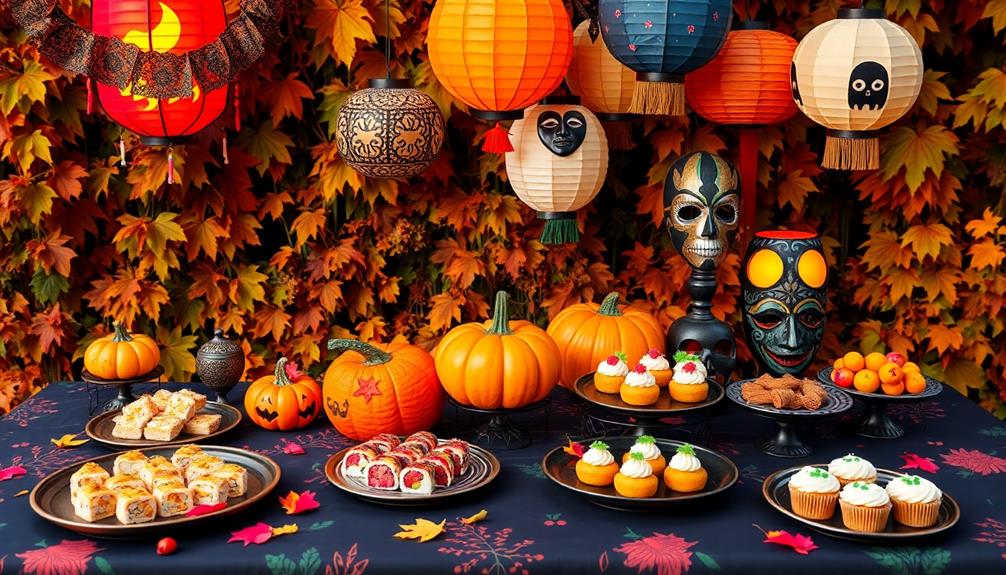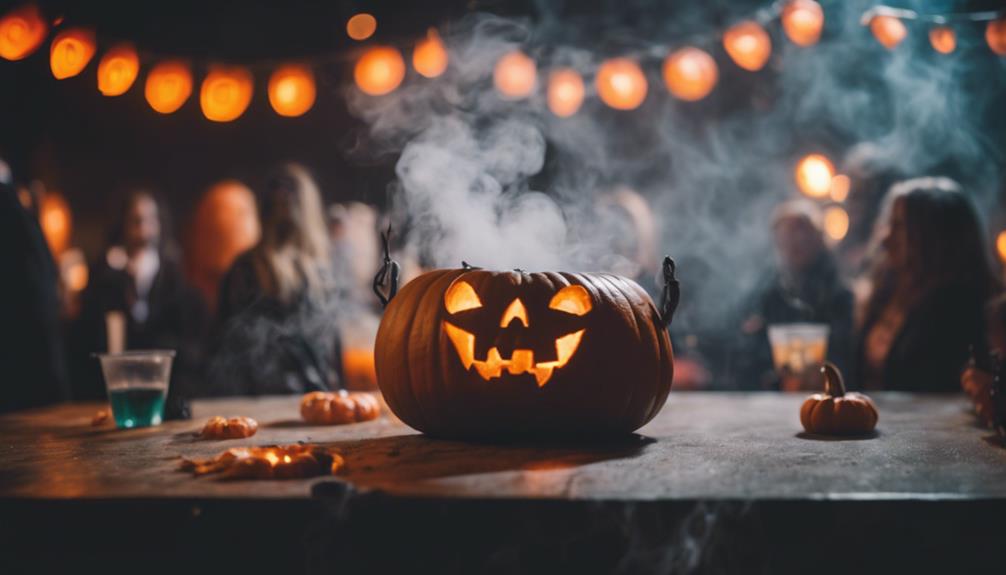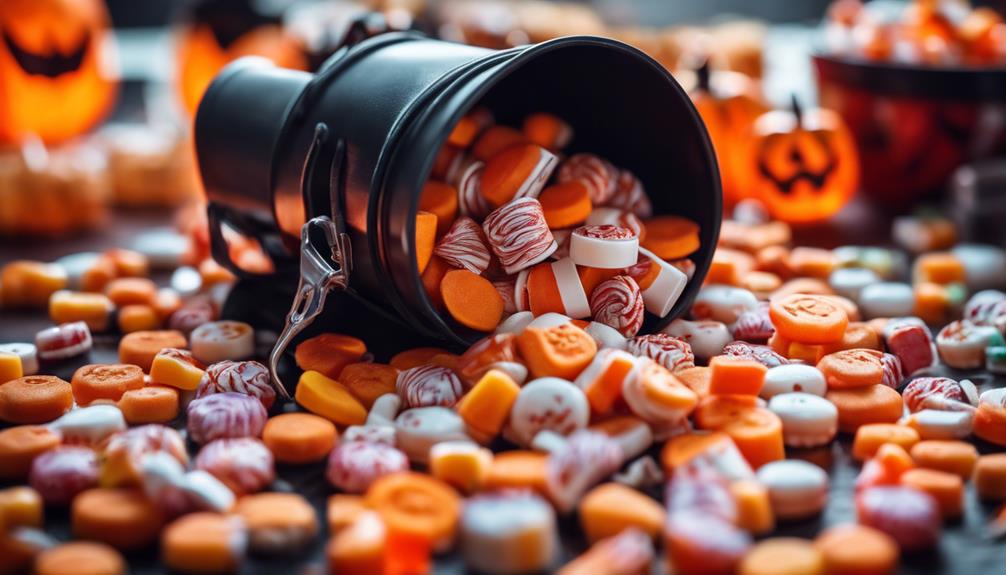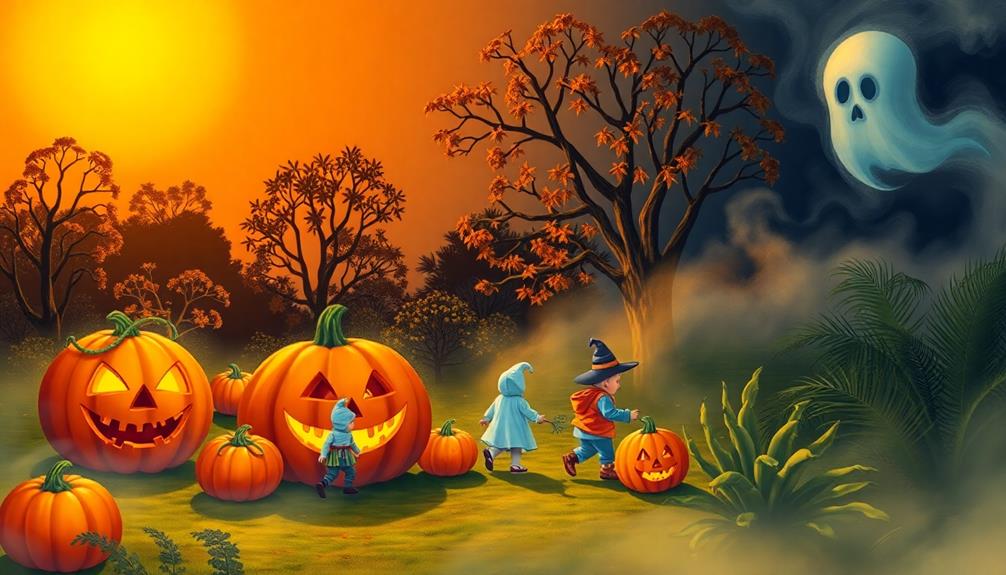Halloween candy has evolved considerably over the years. You've likely noticed how this once was about homemade treats, like cookies and popcorn balls, which fostered community bonds. As the 20th century unfolded, safety concerns shifted the focus to store-bought candies. This change birthed modern classics like candy corn and Reese's Peanut Butter Cups. Now, the Halloween candy market thrives, worth over $3 billion annually, with innovative flavors and health-conscious options on the rise. Understanding this transformation gives you a greater appreciation for your favorite treats. Discover more about how these trends shaped today's Halloween traditions and offerings.
Key Takeaways
- Halloween candy evolved from homemade treats like cookies and fruits to commercially packaged sweets for safety and convenience.
- Iconic candies such as candy corn and Tootsie Rolls emerged in the early 20th century, shaping modern Halloween traditions.
- The Halloween candy market surged post-World War II, driven by increased sugar availability and innovative marketing strategies.
- Current trends reflect a demand for organic, allergen-free, and nostalgic candy options, alongside a growing emphasis on sustainability.
- Future innovations in Halloween candy are expected to focus on healthier options, online sales, and eco-friendly packaging practices.
Historical Development of Halloween Candy

Halloween candy has evolved considerably over the years, especially since the early 20th century when it became closely associated with the holiday.
During the 1900s and 1910s, communities embraced trick-or-treating as a way to reduce vandalism, laying the groundwork for the history of Halloween candy. Initially, children received homemade treats like cookies and fruits, but as safety concerns grew, parents began to prefer commercially packaged options.
By the late 1940s and early 1950s, trick-or-treating became a standard practice in American culture, supported by early media references. This shift marked a significant turning point for the candy industry, which capitalized on the growing demand for convenient and safe treats.
Iconic candies such as candy corn and Tootsie Rolls emerged as Halloween staples, reinforcing their place in tradition.
In the 1960s, targeted marketing efforts from the candy industry further boosted sales, contributing to a booming Halloween candy market that reached an estimated $2.3 billion by 2011.
Today, the evolution of Halloween candy reflects a blend of nostalgia and modern convenience, ensuring that trick-or-treating remains a cherished tradition.
The Origins of Trick-or-Treating

You might be surprised to learn that trick-or-treating traces back to ancient Celtic traditions, specifically the Samhain festival.
As time went on, this practice evolved, merging with Christian customs and transforming into a community event aimed at reducing mischief.
Today, you see it as a beloved Halloween activity that brings neighborhoods together in celebration.
Celtic Festival Traditions
The enchanting traditions of ancient Celtic festivals, particularly Samhain, lay the groundwork for modern trick-or-treating. This festival marked the end of the harvest and the beginning of winter, a time when people believed spirits returned to the earth. To ward off these wandering souls, folks donned costumes and lit bonfires, blending ancient customs with later Christian practices.
One notable tradition was "souling," where people went door-to-door, receiving food or money in exchange for prayers for the deceased. This practice eventually evolved into the trick-or-treating we are familiar with today. As Irish and Scottish immigrants brought these customs to the United States in the 19th century, communities began to embrace this festive practice, leading to a cultural phenomenon.
Here's a glimpse of the shift from Celtic traditions to modern Halloween:
| Celtic Tradition | Modern Equivalent |
|---|---|
| Samhain celebrations | Halloween festivities |
| Costumes to ward off spirits | Trick-or-treating |
| Bonfires | Decorative Halloween bonfires |
| Souling | Collecting sweet treats |
| Community gatherings | Neighborhood trick-or-treating |
Modern Practices Evolution
As traditions evolved from ancient Celtic practices, trick-or-treating emerged as a distinct celebration that reflects community spirit and shared joy. Its roots trace back to the Samhain festival, where costumed individuals sought food offerings to appease wandering spirits. Over time, these customs blended with Christian traditions, paving the way for the modern practice that's recognized today. By the late 1940s, "trick-or-treating" became a popular term in the United States.
In the early 20th century, trick-or-treating served as a community activity aimed at reducing vandalism and encouraging neighborly interactions. It wasn't just about candy; it fostered connections among residents.
By the 1950s, the tradition gained cultural significance, thanks in part to media references like Jack Benny's radio shows and Peanuts comics, which helped solidify its place in American society.
Modern innovations have transformed trick-or-treating into a festive event, with elaborate costumes and themed decorations. The history of Halloween candy has also evolved, with an abundance of choices available, making this beloved tradition even sweeter.
Evolution of Early Halloween Treats

When you think back to early Halloween treats, you might picture homemade cookies, fresh fruits, and even shiny coins shared among neighbors.
However, as the mid-20th century rolled in, convenience and safety concerns shifted the focus to packaged candies.
This evolution paved the way for iconic treats like candy corn and Tootsie Rolls to become Halloween staples.
Traditional Homemade Offerings
During Halloween in the early 1900s, communities thrived on sharing homemade treats, creating a sense of togetherness and warmth. You'd often receive traditional homemade offerings like cookies, fruits, nuts, and even coins when you went trick-or-treating.
These early Halloween treats reflected a community-oriented approach to celebrating the holiday, as neighbors took pride in crafting goodies for local children. This practice of sharing mirrors the importance of budgeting and community support in financial health, as families often relied on each other for resources and assistance, similar to how they'd manage their finances through accountability.
Families would whip up popcorn balls, candied apples, and other delightful snacks, showcasing their creativity and care. The joy of receiving these treats fostered connections, as kids enthusiastically anticipated what each house would offer. It was a time when safety wasn't a primary concern, and trust reigned supreme in neighborhoods.
However, as the mid-20th century approached, the landscape began to change. The rise of trick-or-treating led to a shift towards convenience, pushing many households to opt for store-bought candies instead.
While iconic candies like candy corn had already made their mark, the shift from traditional homemade offerings to pre-packaged sweets ultimately marked a significant cultural change in how we celebrate Halloween, reflecting the growing commercialization of this beloved holiday.
Shift to Packaged Treats
While the charm of homemade treats once defined Halloween, a shift to packaged candies began to take hold as safety concerns and convenience gained prominence. In the mid-20th century, parents worried about the safety of homemade goodies, leading to a growing preference for ready-made options.
By the 1950s, candy companies seized this opportunity, marketing specific candies for Halloween, which encouraged consumers to favor store-bought treats. This shift to packaged treats not only provided increased safety but also aligned with a growing awareness of health and wellness, as families sought to minimize risks associated with food preparation and hygiene, promoting a cleaner environment in their homes health and wellness benefits.
This shift to packaged treats offered numerous benefits:
- Safety: Pre-packaged candies reduced the risk of tampering.
- Convenience: Ready-made options made it easier for parents and kids.
- Variety: A broader selection of flavors and textures became available.
- Tradition: Classic favorites like chocolate bars became Halloween staples.
As kids roamed the streets with their plastic pumpkin buckets, the evolution toward store-bought confections marked a significant change in Halloween culture.
This change not only made trick-or-treating more enjoyable but also allowed candy companies to flourish, creating an industry that would forever change the way we celebrate this spooky holiday.
Iconic Candies Emergence
Halloween's iconic candies didn't just appear overnight; they evolved from humble beginnings into beloved treats that define the holiday today. In the early 1900s, neighbors shared homemade cookies, nuts, and fruits during festivities, fostering a sense of community. However, the 1950s brought a seismic shift as commercially packaged candies started dominating the market, leading to the emergence of favorites like Reese's Peanut Butter Cups.
Throughout the years, certain candies became synonymous with Halloween. Candy Corn, created in the late 1800s, faced ups and downs in popularity but remains a staple today. The 1970s ushered in individually-wrapped candies, enhancing safety and convenience for trick-or-treaters. By the 1980s, innovative treats like Skittles and Sour Patch Kids reflected changing consumer tastes, expanding the variety of iconic candies associated with the holiday.
| Year | Candy Name | Significance |
|---|---|---|
| 1800s | Candy Corn | First Halloween-themed candy |
| 1950s | Reese's Peanut Butter Cups | Emergence of commercial candies |
| 1970s | Individually-wrapped Candy | Enhanced safety for kids |
| 1980s | Skittles | Reflects changing tastes |
| 1980s | Sour Patch Kids | Expanding candy variety |
Rise of Popular Halloween Candies

Over the years, countless candies have emerged as favorites during Halloween, shaping the way we celebrate this spooky season. As you prepare your trick-or-treat bags, you can't help but notice the rise of popular Halloween candies that kids enthusiastically anticipate each year.
Some of the most iconic options include:
- Candy Corn: This classic, created in the late 1800s, boasts an annual production of 35 million pounds, totaling around 9 billion pieces.
- Tootsie Rolls: Introduced in 1907, these chewy delights remain a Halloween staple, synonymous with trick-or-treating.
- Reese's Peanut Butter Cups: Since their debut in the 1950s, these treats have become a favorite among kids and adults alike.
- Skittles and Starburst: Launched in the 1970s, these fruity candies quickly became common additions to Halloween treat bags.
The emergence of unique candies like Nerds and Laffy Taffy in the 1970s reflects how consumer demand for fun, interactive sweets has grown.
These popular Halloween candies not only satisfy your sweet tooth but also enhance the excitement of this beloved holiday.
Innovations in Candy Design

Innovations in candy design have transformed your Halloween experience, making it more exciting and interactive than ever before. The 1970s brought standardization of individual wrappers for Halloween candies, enhancing hygiene and convenience for trick-or-treaters.
Fast forward to the 1980s, when "gross-out" candy trends emerged, inspired by pop culture, leading to the creation of innovative treats that kept the fun alive all year round.
Candy corn, once dismissed as "chicken feed," evolved into a Halloween staple, now available in seasonal variants and specialty flavors. This shift reflects how candy manufacturers adapted to consumer preferences, turning a simple treat into a festive favorite.
In the 1990s, novelty items like edible bubbles entered the scene, showcasing the growing demand for interactive candies that engage your senses.
Today, manufacturers focus on seasonal marketing strategies, offering unique packaging and flavors that capture your attention and maintain your interest throughout the year.
With each new innovation, Halloween candy becomes not just a treat but a spectacular experience, inviting you to explore the playful side of confectionery delights.
Cultural Significance of Candy

Candy plays a pivotal role in our Halloween celebrations, symbolizing abundance and joy. Its cultural significance is deeply rooted in historical practices, where ancient cultures associated sweets with fall festivals and preparation for winter.
Today, modern Halloween embraces this tradition, showcasing the importance of candy in our festivities. Many popular candies, like Skittles and Starburst, are known for their high sugar content, which adds to the indulgent experience of Halloween candy with high sugar content.
You might notice how candy consumption during Halloween isn't just about satisfying a sweet tooth; it reflects community spirit and shared joy. Consider these points:
- 35 million pounds of candy corn produced annually, equating to about 9 billion pieces consumed.
- Despite mixed feelings, candy corn remains a staple, much like cranberry sauce at Thanksgiving.
- Trick-or-treating practices have evolved, enhancing safety and health in response to events like COVID-19.
- The marketing of Halloween candy has shifted from targeting shopkeepers to direct consumer approaches, influencing consumption patterns.
These elements highlight how candy has become an integral part of the Halloween experience, fostering connections among families and friends while celebrating the season.
As you indulge in your favorite treats, remember the rich cultural significance behind your sweet selections.
Marketing Trends and Strategies

With the cultural significance of candy firmly established, it's fascinating to explore the marketing trends and strategies that have shaped how these treats are sold during Halloween. In the 1960s, Brock's revolutionized the industry by shifting focus from shopkeepers to households, targeting consumers directly. This move notably boosted Halloween candy sales and set the stage for future innovations.
The marketing approach in the candy industry reflects broader trends, similar to the way Nastia Liukin's success journey illustrates the importance of branding and strategic investments.
The 1970s introduced themed candies like marshmallow peeps, enhancing variety and sparking consumer interest. By 2011, Halloween candy sales had skyrocketed to an estimated $2.3 billion, accounting for over one-third of total Halloween spending, which reached around $6 billion.
Today's seasonal marketing strategies allow candy manufacturers to promote Halloween-themed products long before the holiday, often starting weeks or even months in advance. This early promotion maximizes visibility and drives sales, ensuring that consumers are prepared for their sweet celebrations.
The average Halloween Jack O' Lantern holds about 250 pieces of candy, a staggering figure that underscores the scale of candy distribution and consumption during this festive time.
It's clear that effective marketing plays an essential role in shaping the Halloween candy landscape.
Future of Halloween Candy

As consumer preferences shift, the future of Halloween candy is set to embrace a range of healthier options, including low-sugar and organic treats.
You'll notice that candy manufacturers are responding to the demand for dietary-specific products, making it easier for you to enjoy Halloween without the guilt.
Additionally, expect to see a rise in herbal-infused treats that offer unique flavors and potential health benefits, such as those found in herbal teas.
Expect to see innovative treats that not only satisfy your sweet tooth but also align with your lifestyle choices.
Some trends to watch for include:
- Low-sugar and organic options that cater to health-conscious consumers.
- Tech-driven interactive elements, like augmented reality packaging, enhancing the trick-or-treat experience.
- Seasonal shapes and themed packaging for classics like Reese's to keep things exciting.
- New flavors and unique ingredients, featuring exotic fruits and spices to stand out in a crowded market.
Sustainability will also play a vital role in the future of Halloween candy.
Companies are likely to adopt eco-friendly packaging solutions, reducing their environmental impact and aligning with your values.
Embrace these changes, and look forward to a Halloween filled with both delightful and responsible candy choices!
Frequently Asked Questions
When Did the Modern Version of Trick-Or-Treating for Halloween Candy Become Popular?
The modern version of trick-or-treating gained popularity in the late 1940s and early 1950s. You'll find it became a cherished community activity, encouraging fun while reducing vandalism and fostering neighborhood connections during Halloween.
What Is the History of Candy at Halloween?
You won't believe how candy transformed Halloween! Initially, folks handed out homemade treats, but by the mid-20th century, packaged candies like candy corn and Tootsie Rolls became irresistible staples, igniting a sweet tradition that's still thriving.
Why Is Halloween Candy Smaller This Year?
Halloween candy's smaller this year mainly due to rising production costs and inflation. Companies are responding to your demand for budget-friendly options while promoting portion control, making it easier for families to enjoy the celebration responsibly.
What Did Kids Get Trick-Or-Treating Before Candy?
Before candy became the norm, you'd often find homemade treats like cookies or popcorn balls in your bag. Sometimes, neighbors handed out fruits, nuts, or even coins, making trick-or-treating a diverse experience.
Conclusion
As you plunge into the sweet world of Halloween candy, it's clear this tradition has come a long way. From homemade treats to iconic favorites, candy has become a staple of the holiday, capturing the hearts of kids and adults alike. As companies innovate and marketing strategies evolve, you can bet this sugary celebration will continue to grow. So, grab your trick-or-treat bag and enjoy the ride—it's a sweet journey you won't want to miss!









